

|
| DEUTSCHLAND | GERMANY |
| Bundesland: Baden-Württemberg | |
| Regierungsbezirk: Freiburg | |
| Landkreis: Waldshut |
Bad Säckingen is situated at an elevation of 291 m on the right bank of the river Rhine, about 32 km west of the district town Waldshut-Tiengen and about 35 km east and upstream of Basel. The municipality has a population of about 17,100 (2016).
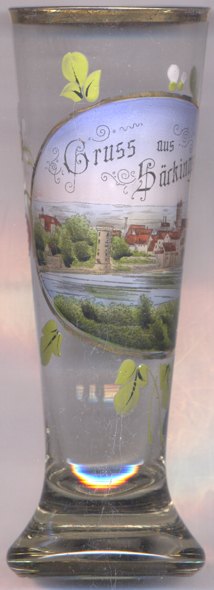
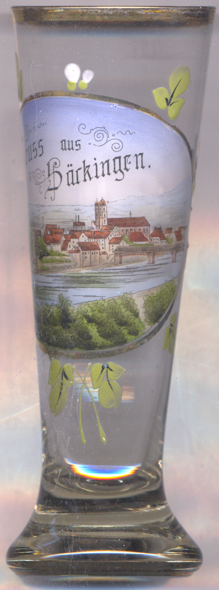 The earliest known document mentioning Seckinga dates from 878. Although traditionally explained as being derived
from Alemannic Secco, it is actually more likely derived from the Latin place name Sanctio (maybe derived
from the name of the province Maxima Sequanorum that had been founded in 297 AD. The modern town
was founded near the monastery and ladies' convent, which itself was founded in the 7th century. In 1805, Säckingen
became part of the Duchy (1806 Grand Duchy) of Baden. Until 1830, the town was situated on an
island in the river, but in 1830 th right branch of the river was filled up. The former left branch of the Rhine today
marks the border between Germany and Switzerland. The district Säckingen was dissolved in 1973 and for the most part
was merged with the district Waldshut. The former independent communities of Rippolingen and Wallbach were merged with
Säckingen in 1973. In 1978 the attribute Bad (spa) was added to the name of the municipality.
The earliest known document mentioning Seckinga dates from 878. Although traditionally explained as being derived
from Alemannic Secco, it is actually more likely derived from the Latin place name Sanctio (maybe derived
from the name of the province Maxima Sequanorum that had been founded in 297 AD. The modern town
was founded near the monastery and ladies' convent, which itself was founded in the 7th century. In 1805, Säckingen
became part of the Duchy (1806 Grand Duchy) of Baden. Until 1830, the town was situated on an
island in the river, but in 1830 th right branch of the river was filled up. The former left branch of the Rhine today
marks the border between Germany and Switzerland. The district Säckingen was dissolved in 1973 and for the most part
was merged with the district Waldshut. The former independent communities of Rippolingen and Wallbach were merged with
Säckingen in 1973. In 1978 the attribute Bad (spa) was added to the name of the municipality.
The  Fridolinsmünster (minster church of St. Fridolin)
[left, no. 3478: background right] is the popular landmark of the town. It is dedicated to
Saint Fridolin of Säckingen, a missionary monk from Ireland who died here in 538 AD. Te church originally
was the church of the ladies' convent. Built first in Romanesque style, it was rebuilt after a large fire in Gothic style
in the 14th century, and renovated in Baroque style in the 17th and 18th century. The relics of St. Fridolin
are kept in the Fridolin chapel in the church's choir.
Fridolinsmünster (minster church of St. Fridolin)
[left, no. 3478: background right] is the popular landmark of the town. It is dedicated to
Saint Fridolin of Säckingen, a missionary monk from Ireland who died here in 538 AD. Te church originally
was the church of the ladies' convent. Built first in Romanesque style, it was rebuilt after a large fire in Gothic style
in the 14th century, and renovated in Baroque style in the 17th and 18th century. The relics of St. Fridolin
are kept in the Fridolin chapel in the church's choir.
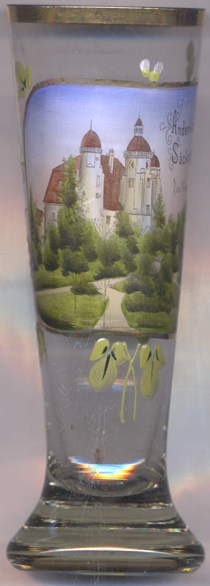
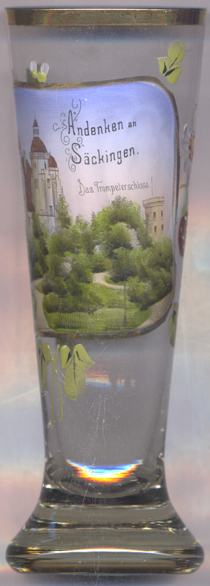
 Schönau castle [left, no. 3479], popularly known also as
Trumpeter's castle, was built in 1600–1680 for the Schönau family. Two of the originally four
corner towers were broken off in the 17th century. At the same time, a central tower was added between the remaining two
corner towers. In the 19th century, when the castle had been in use as a brewery, part of the historic substance was lost.
In 1928 the municipality of Säckingen purchased the castle and renovated it for the High Rhine Museum.
the popular name 'Trumpeter's castle' alludes to the marriage of the commoner Franz Werner Kirchhofer (1633–1690)
with the noble lady Maria Ursula von Schönau (1632–1691), popularised in the epic poem
Der Trompeter von Säckingen by Joseph Victor von Scheffel, published in 1854.
Schönau castle [left, no. 3479], popularly known also as
Trumpeter's castle, was built in 1600–1680 for the Schönau family. Two of the originally four
corner towers were broken off in the 17th century. At the same time, a central tower was added between the remaining two
corner towers. In the 19th century, when the castle had been in use as a brewery, part of the historic substance was lost.
In 1928 the municipality of Säckingen purchased the castle and renovated it for the High Rhine Museum.
the popular name 'Trumpeter's castle' alludes to the marriage of the commoner Franz Werner Kirchhofer (1633–1690)
with the noble lady Maria Ursula von Schönau (1632–1691), popularised in the epic poem
Der Trompeter von Säckingen by Joseph Victor von Scheffel, published in 1854.
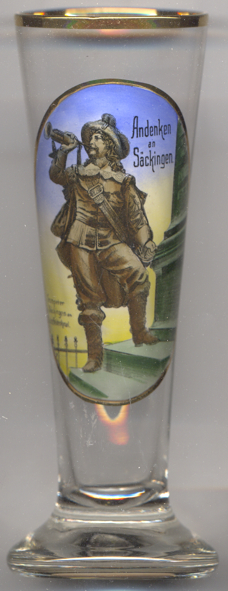
The  monument for Joseph Victor Scheffel was unveiled in 1901 in Münsterplatz square.
It consisted of a bronze bust of Scheffel placed on a granite base, a larger-than-life bronze statue of the trumpeter
[depicted on glass no. 3854, left]. The monument was created by the Munich
sculptor Joseph Wilhelm Menges. The cost of 25,000 Reichsmarks came from donations and a city grant; even Emperor
Wilhelm II and Grand Duke Friedrich I of Baden had donated. Until about 1933 the monument was surrounded by a
wrought iron fence. The fence was removed in the 1930s and replaced by a spacious fountain. In 1941, during World
War II, the monument was removed to melt down the metal; only the Scheffel bust could be saved and today is located
in the castle park.
monument for Joseph Victor Scheffel was unveiled in 1901 in Münsterplatz square.
It consisted of a bronze bust of Scheffel placed on a granite base, a larger-than-life bronze statue of the trumpeter
[depicted on glass no. 3854, left]. The monument was created by the Munich
sculptor Joseph Wilhelm Menges. The cost of 25,000 Reichsmarks came from donations and a city grant; even Emperor
Wilhelm II and Grand Duke Friedrich I of Baden had donated. Until about 1933 the monument was surrounded by a
wrought iron fence. The fence was removed in the 1930s and replaced by a spacious fountain. In 1941, during World
War II, the monument was removed to melt down the metal; only the Scheffel bust could be saved and today is located
in the castle park.
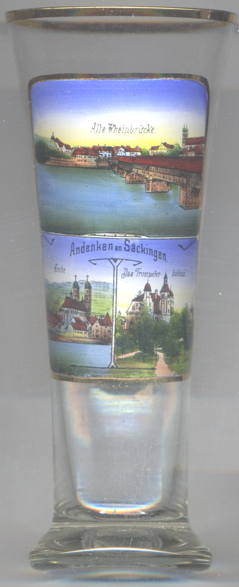
The  old
old
[https://de.wikipedia.org/wiki/Bad_Säckingen, https://en.wikipedia.org/wiki/Bad_Säckingen;
https://de.wikipedia.org/wiki/Fridolinsmünster, https://de.wikipedia.org/wiki/Fridolin_von_Säckingen;
https://de.wikipedia.org/wiki/Schloss_Schönau_(Bad_Säckingen);
https://www.trompeter-von-saeckingen.de/scheffel/scheffeldenkmal.htm, https://www.trompeter-von-saeckingen.de/scheffel/scheffelfest1901.htm]
![[scale]](lineal.jpg)